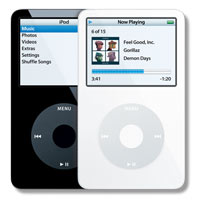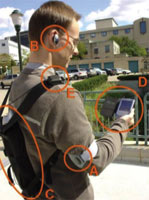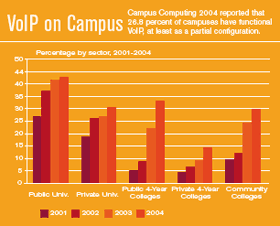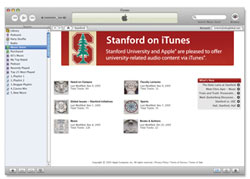- 35
-
Imagination on the move

In our July 2005 issue, Campus Technology reported on the new wireless network at UCLA's Anderson School of Management. With the help of wireless vendor 5G Wireless, the Anderson School was able to cover 85 percent of the space with a G-Force Base Station—one access point on a pole or mast. And, with significant savings, Eric Crane, Network Infrastructure, Security, and Server manager says the biggest savings was the maintenance. Instead of having to maintain five or six dozen access points, staffers at Anderson Computing and Information Services (ACIS) need only to worry about six, freeing them up to extinguish IT fires elsewhere on campus. Read the article
- 36
-
Transforming how students use mobile phones
Students at Montclair State University (NJ) can now use their cell phones in more ways than they imagined. Montclair's Campus Connect allows students to customize their mobile phones for 24/7 access to all the information and resources needed to manage their academic, community, and social lives on campus. "
Rave Wireless took the preferred communications device of the youth market and, working with the university, transformed it into an educational and community-building tool that will enable Montclair State to take a huge leap forward in preparing our students for productive roles in a technology-based society," says Susan A. Cole, president at Montclair. With the new technology students can: receive realtime alerts and information from the university; track the actual location of the campus shuttle buses; check class assignments and study hall availability; read and create personal mobile blogs; coordinate group activities and trips; and access health- and safety-related information.
- 37
-
Homegrown CMS

Georgetown University
(DC) has taken a different approach to mobile computing by focusing on information via podcasting and text messaging. Through the school's homegrown content management system, dubbed Explore, the school is getting more life out of the content than ever before, explains Robert Michael Murray, director of Technology Strategy and Development. "With wireless networks virtually everywhere, we didn't doubt that users would engage in mobile computing," he says. "For us, the missing piece was making sure our content was as mobile as the technology itself; making sure we could send any piece [of content] to any device in any place at any time." Students, faculty, and staff will be taking advantage of the new system by using iPods and other multimedia devices. Murray says that professors are looking into the possibility of recording lectures and making them available to download via Explore. Read the article
- 38
-
Vodcasting lectures
As reported in CT's News Update eLetter, in an effort to grant widespread access to academic events for a broad audience, Princeton University (NJ) has added vodcasts (video podcasts) of academic lectures and events—launched this summer and available for downloading on its Web-based University Channel (uc.princeton. edu/main). University Channel Executive Director Donna Liu said she initiated podcasting because "commercial media d'esn't put out full-length presentation."
- 39
-
Inspiring faculty to integrate technology with education
Seton Hall University's (NJ) Mobile Computing Program requires that all freshmen have a portable PC, so the school purchased IBM ThinkPad laptops and leased them to the students at a discount. Seton's CIO Stephen Landry worked toward a curricular integration—an effort to support and encourage faculty to integrate the use of laptops in the curriculum. "The whole idea was to inspire our faculty and department heads to use mobile technology to improve student learning," says Paul Fisher, the center's director. Read the article
- 40
-
Yahoo! music pilot program
The first institution/university-based partnership for Yahoo! now lets students at Stanford University (CA) experience and access more than a million songs. Stanford is working with Yahoo! and an anonymous donor on a pilot project that gives undergraduate and graduate students free subscriptions to the search engine's music service. Further, students can share music by using Yahoo! Messenger, or transfer as many tracks as they want onto compatible portable and mobile devices.
- 41
-
Smarter smartphones

In essence, what is a smartphone? It is a handheld device that integrates personal information management and mobile phone capabilities. At
Carnegie Mellon University (PA), researchers under the leadership of Professor Asim Smailagic have developed a mobile, wearable system that is one part PDA, one part cell phone, and one part virtual secretary (it can screen calls and send them to voicemail if the user is in the middle of a class or important meeting). The next step for the system, dubbed SenSay: Smailagic hopes to network SenSay into the school's wireless network and create a plug-in application that expands the context for these context-aware tools. Read the article
- 42
-
Reliable wireless connectivity for reliable communications
The University of Central Arkansas had difficulty with wireless signals in its basement classrooms and wireless coverage in and around buildings. UCA wanted to deploy a solution that could add more reliable network coverage and capacity, yet wouldn't cost an arm and a leg. Administrators selected ADC's Digivance Long-Range Coverage Solution and Indoor Coverage Solution, which made it possible for students and faculty to have complete access to the university's network and other services via portable computers, mobile phones, and other wireless communication devices. According to Ronald Toll, formerly dean of the school's College of Natural Sciences and Mathematics and special assistant to the president for Technology and Corporate Relations, students can now stream Web-based information and conduct Web-based research. Student presentations can even blend audio and video media forms.
- 43
-
Driving IT and network innovation
CIO and vice president for Information Technology at Duke University (NC), Tracy Futhey has been noted for her work with Duke's iPod project and has been involved in significant network innovation. When asked what she has learned about the nature of innovation, Futhey says that the most critical enlightenment is tied to relationships with faculty. "In terms of a strategy, I'm very big on the notion of working with faculty; meeting with faculty...and understanding what capabilities they need or may be creating. That's the key to innovation: viewing technology not simply as infrastructure, but as the gateway that can help provide faculty and students with advanced capabilities." Read the article
- 44
-
A parked improvement
As reported by Matt Villano in the November 2005 issue of CT, many schools have simply too many cars and not enough parking spaces. Such was the case at the University of California-Santa Barbara.With nearly 25,000 students, faculty, and staff members, and only 6,000 parking spots, parking was a real challenge for anyone visiting the campus during the weekday. "The situation on campus was pretty bad," admits Tom Roberts, the school's director of Transportation and Parking Services. "We knew there simply had to be a better way." After much research, Roberts turned to the
International Parking Institute for inspiration, and found a parking solution from Digital Payment Technologies. DPT installed the technology at pay stations and set up wireless access points to link them together over a campuswide wireless network. Mobile commerce solutions provider, Verrus, merged the university's physical pay stations with software to enable users to pay for parking remotely, from any standard mobile device—even via a cell phone. In addition, UCSB parking patrol officers are now equipped with PDAs that send them up-to-the-minute information about soon-to expire parking spaces. Read the article
- 45
-
Campus trends—wireless and VoIP/
Casey Green's 2004 Campus Computing Survey revealed continuing gains in the deployment of wireless networks (Wi-Fi) on campuses. Institutions ranked wireless among their "Top 5 Issues" in the 2004 survey, and 55.3 percent reported that they had strategic plans for wireless networking. The survey has also tracked VoIP deployment since 2001, and the 2004 survey reports that 26.8 percent of surveyed institutions now have VoIP installations in place. Read the article
- 46
-
Reaching out to more students

With more than 20,400 students at the University of Hawaii-Manoa—both on-campus learners and distant learners—the school's administrators felt a need to address their instructor shortage. In 2002, the college's office of Technology and Distance Programs was established to address this need, and recently, the College of Education at the University of Hawaii implemented a year-long pilot project using a live eLearning environment. "In an effort to shift from travel to synchronous education, we are using Elluminate Live! to eliminate a single weekend of travel this semester, which represents about $4,500 in savings," said Paul B. McKimmy, director of Technology and Distance Programs for the College of Education. The technology has enabled learning at UH to become mobile, and provides instruction to a larger number of students, including more students with disabilities.
- 47
-
Debunking the myths of wireless network coverage
Instrumental in implementing a wide-area network (WAN) on his campus, Eric Crane, manager of Network Infrastructure, Security, and Servers at the UCLA Anderson School of Management, debunks the myth that you must have high data rates for your mobile users. Crane comments: "Mobile users commonly use less data-intensive apps such as e-mail." Crane g'es on to say that typically, only 20 percent of users are on the network at any given time, a factor that curbs the load. Read the article
- 48
-
The value of a partnership
As reported in June 2005, in an effort to extend the vision of content collaboration on campus, Agilix Labs Inc., the mobile learning application provider, has entered into a partnership with Blackboard, to deliver offline mobile learning solutions for students, instructors, and system administrators. The partnership will enable users to synchronize educational resources and keep information current on students' or instructors' PCs, even when campus networks are unavailable. Read the article
- 49
-
The classics on the iPod
Podcasting has enabled a new generation of mobile learning and listening. As colleges and universities recognize the potential to make learning more dynamic through sound and sight, students are expecting these technologies to become available at their schools. To bring classic literature into the classroom. SparkNotes, an electronic study guide provider, and iPREPpress, a downloadable educational study provider, have developed a study-guide like solution to enhance learning via the new video-enabled iPod. Using their iPods, students can access SparkNotes guides and get the context, plot overview, summary and analysis, theme, motives, and key facts and quizzes for such classics as The Adventures of Huckleberry Finn, The Catcher in the Rye, The Great Gatsby, Hamlet, and others.
- 50
-
Pocket portal
As detailed by John Savarese in April 2005 CT, PDAs have evolved to connect students, faculty, and staff to their schools in more ways than one. Drexel University (PA) has developed DrexelOne Mobile, an extension of the university's DrexelOne portal built on SunGard SCT Luminis and SCT Banner, and the campus's Dragonfly wireless network. Using any device with Internet access— desktops, PDAs, and other handhelds—students can check grades and class schedules, record holds, or other significant events. The next step: eCommerce. "I see a student lining up for his graduation cap and gown, only to be told that he has an outstanding fine at the library and is on financial aid hold. While still in line, that student would be able to use his PDA or cell phone to pay the fine and get the hold removed," says Kenneth Blackney, associate VP for Core Technology in the Office of Information Resources & Technology at Drexel. Read the article
- 51
-
POS in the palm of your hand
Not long ago, Duke University (NC) began using wireless Palm units for textbook buy-backs at remote locations. Today, wireless handhelds enable Duke's bookstore to handle buy-backs in the main student union where most of the student traffic flow exists. Duke's campus store has also started using Palms instore and for wireless receiving in the warehouse. Employees now call up orders via the devices and receive items all at once, versus searching through files for individual purchase orders that must then be received individually.
- 52
-
24/7—global and mobile
At Hobart and William Smith Colleges (NY), students are immersed in a 24/7 global learning environment. In an effort to boost the mobile learning environment, the college teamed with technology provider CDW-G to offer their students IBM ThinkPad laptop computers. Students are able to run instructional software, access course materials, obtain advising resources, access campus event information, use e-mail, and do research on the Internet from anywhere on campus.
- 53
-
Smart podia—the latest in mobile presentation technology
New York University is innovating through the school's "smart podia," a variety of pedestals that enable professors to access and utilize lecture materials from any folder on the campus network. The devices, which are set up only in certain classrooms, are essentially stationary networked computers equipped with all of the latest in presentation technology (e.g., projectors and other presentation tools). From them, professors and lecturers can log on to Web-based storage folders and access notes, PowerPoint slides, or other support materials. They can then control the flow of a presentation with the click of a button. Because the podia are connected to the campus network, they eliminate the need for users to lug laptops or notebooks to class. "[The podia] certainly make everyone's lives easier," says Marilyn McMillan, associate provost and chief Information Technology officer. "When it comes to mobility, having a certain number of worthwhile technologies g'es a long way." Read the article
- 54
-
Business students and a 'real world' BlackBerry program

College students are becoming less reliant on their desktop computers to check e-mail and use instant messaging, and now students at the University of Maryland have the opportunity for a unique mobile learning/communication experience at the Robert H. Smith School of Business. All full-time MBA students are outfitted with a BlackBerry 7510 wireless handheld device from Sprint. "Our students will be entering a business world where 24/7 communication is fast becoming the norm, and in some cases, is expected," says Cherie Scricca, associate dean for Master's Program and Career Services at the School of Business. As a result, according to Sprint Nextel spokespeople, students may develop new communication habits and styles. Most importantly, MBA students will gain firsthand exposure to information technology and how it can be used to drive business innovation, productivity, and growth.
- 55
-
The most 'unwired' campuses
Ball State University
(IN), Western Michigan University, and the University of Akron (OH) were named first, second, and third most "unwired" campuses in the US, in a ranking by the makers of the Centrino chip, Intel Corp.. Intel says its survey—conducted in conjunction with the Center for Digital Education—shows that 98 percent of the top 50 campuses are covered by a wireless network, up from 64 percent in 2004, with 74 percent having 100 percent wireless network coverage on campus, up from just 14 percent last year. "Wireless Internet is part of everyday life for students now," says Viji Muralidharan, VP for IT and CIO at Western Michigan. "We provide access that lets students access the Internet anytime and anywhere." Other unwired schools include Dartmouth College (NH) and Carnegie Mellon University (PA). Read the article
- 56
-
Delivering a wireless solution
"It is critical that our students have continuous access to the tools and resources they need to be successful—not only in their residence halls or classrooms, but wherever they may be on campus," says John Urbanick, chief technology officer for Ferris State University (MI). With more than 12,000 students and growing, it's no wonder that Ferris State needed to deploy a solution providing mobile hot zones. Urbanick and his team turned to Nortel's Campus Mobile Worker solution, which included wireless mesh and WLAN technologies, giving students, faculty, and staff at Ferris State access to critical personnel and information, any time they are on campus, whether indoors or outdoors. Overall, the solution helped to lower operational expenses, increase worker productivity, and improve customer satisfaction because of the faster response time. In addition, Campus Mobile Worker supports SIP-based multimedia and collaborative applications such as video conferencing, instant messaging, and file sharing—giving users on campus even more options.
- 57
-
Retrofitting classroom technology
In an age when schools are refining and streamlining technologies on campus, many have opted for solutions that combine equipment, resources, and tools into a single, mobile component. Intelligent or "smart" classrooms have enabled instructors to do just that—"streamline lectures, making them more interactive and effective," says John Mullen, VP of sales for Dell Higher Education. Miami Dade College (FL), for one, selected Dell to outfit 88 classrooms across three campuses with wired desktops, flat panel monitors, projectors, VHS and DVD players, sound installation, and custom security mounts—networked and backed-up via Dell PowerEdge. The combination of technologies will better equip instructors and provide students and faculty with greater mobility and convenience, says Dell reps. The college plans to bring smart classrooms to all eight campuses in the next two years.
- 58
-
Supporting hundreds of applications...

on more than 5,000 desktops and servers, Northeastern University (MA) was challenged to ensure that its faculty and students had the applications they needed—anywhere, anytime. Northeastern spokespeople state that initially, managing the diverse environment posed many difficulties. For instance, at the beginning of each semester, the school received the latest applications for teaching and classroom support, which it systematically rolled out campuswide. Administrators were faced with some last-minute requests for updates that they found difficult to tackle, as well as installation incompatibilities and support and resource constraints. Enter SoftGrid from Softricity . According to Softricity reps, the school needed a system that would solve its application deployment and multi-versioning issues, and enable IT to quickly and easily service needs for the latest applications. Also, SoftGrid allows NU administrators to accelerate each step of the application management process by "compressing the time necessary for packaging and preparing applications, deployment, patch management and updates, support, and termination." Read the article
- 59
-
Taking maps to the next level
The Massachusetts Institute of Technology is truly on the wireless "map." MIT will now "provide information on exactly how many people are logged on at any given location at any given time" via a new map service, reports the Associated Press, regarding MIT's new iSpots project. "It even reveals a user's identity if the individual has opted to make that data public." Carlo Ratti, director of the school's SENSEable City Laboratory (creators of the map), informed AP that one can even "watch" an individual go from room to room, if he has a handheld device that's connected. "Laptops and Wi-Fi are creating a revolutionary change in the way people work," said Ratti in the interview, explaining that the maps help to "visualize these changes by monitoring traffic on the wireless network, and showing how people move around campus." More on the iSPOTS project
- 60
-
Wall street simulated
Tulane University's (LA) A.B. Freeman School of Business brings Wall Street to the classroom with a training center that simulates the activity around the financial hub. The school uses Christie Digital's projection cubes to create a screen that spans the walls of the school's trading center. A separate controller can display multiple images on different screens, or one large image across the entire wall— bringing the real world of high finance right into the classroom.
- 61
-
21st century learners
CT's IT Training columnist, David Starrett, and his colleagues at
Southeast Missouri State, refer to 21st century learners as digital natives, but also digital immigrants who are influenced and impacted by technology in and out of the classroom. "Twenty-first century learners have different expectations of teachers, of the content, of the delivery, and of access to that content," said Starrett in his September 2005 column, "Do We Have to Talk the Talk?" According to Starrett, students—constantly connected to instant messaging programs and other mobile devices—are changing the way people communicate, via the use of acronyms. Starrett suggests instructors meet students somewhere in between conventional communication and IM lingo, adjusting to eLearning style, but maintaining some of the traditional approaches. Read the article
- 62
-
Online collaboration for the virtual interactive classroom
"While an e-mail can take minutes to compose, a question after a real-time class can be addressed in seconds," says Judith V. B'ettcher, CT's eLearning columnist, in her May 2005 column. B'ettcher notes that synchronous tools are now more specialized, and have been better designed for collaborative interactions. At Purdue University (IN), for instance, instructors wanted an "application-sharing tool that is able to be pumped around the world." Purdue's faculty and administrators elected to use Macromedia's Breeze Live for small group and interactive meetings. B'ettcher says, "The capabilities of these new [synchronous] tools bring us to a new place that shares many of the capabilities of the old, familiar classroom." For more on synchronous learning, listen to B'ettcher's plenary panel from the Syllabus2005 conference.
- 63
-
Dealing with the Downside
As excerpted from "Technology and the CEO: Wireless on Campus," by David R. Black: "When was the last time you saw a college (or junior high, or high school) student without a cell phone? Again, familiarity with portable wireless devices allows most students to embrace the 'unplugged' world. Add to this the proliferation of PDAs, wireless printers, keyboards, and mice, and a student could conceivably go through four years of college without tripping over a wire. Most important, wireless is a facilitator on several levels: With proper authentication/encryption, accessing student data from residence halls and public areas is safe. Students can thus collaborate on the Web, check course syllabi, instant message friends, send assignments to their professors, and check on the status of their laundry from their residence hall. Parents can access student accounts from home, deposit money in individual school debit accounts, and provide for their children many, many miles from home. Pervasive computing and attendant issues follow both student and professor into the classroom. Because a laptop, tablet, or PDA in class is such a departure from the traditional notebook, paper, and pencil, some professors may be wary of the inherent distraction of Web accessibility during instruction.
Browsing the Web or instant messaging a friend during a lecture can be a common occurrence; taking notes can become secondary to instant entertainment. At that point, allowing laptops in class for note-taking may not be the best answer to meeting students' needs for technology. It is important to recognize that technology in general (and computing in particular) has a sociopersonal element that students easily integrate into their lives." Read the article
- 64
-
Stanford & iTunes

As covered in the October 26, 2005 edition of CT's C2 online newsletter, Stanford University (CA) students, university alumni (and the general public) can now stay connected with university resources and information via Stanford on iTunes. Several types of content will be provided: faculty lectures, information about campus events and performances, music offerings from the Stanford community, and podcasts covering Stanford football. Howard Wolf, vice president for Alumni Affairs and president of the Stanford Alumni Association, comments to the Stanford Report: "Stanford has been fortunate to partner with Apple in a project that allows us to share the intellectual and cultural life of the university with our alumni." The system will allow restricted access to course-related content as well as free public access to non-students and faculty, where appropriate. According to CNET, the technology review Web site, faculty, students, and over 180,000 Stanford alumns have access to inexpensive digital content. Stanford's alumni relations officer David Vargas remarked, "that number will grow exponentially over time and will soon include video content as well."
- 65
-
Mobile technology in the background
During a Syllabus2004 panel discussion, William Griswold, a professor in the Department of Computer Science and Engineering at the University of California-San Diego, commented that the university has deployed over a thousand 802.11b points on the campus. UCSD also received a gift from HP of several hundred wireless PDAs, 350 of which were distributed across three different classes, so that students could fully incorporate the devices in and out of the classroom. In addition, Griswold and his students introduced an application called ActiveClass— software designed for in class communications— in the lecture setting. "Students could ask questions via their wireless PDA, professors could post polls, and students could give feedback to the professor," said Griswold. "The idea was that there could be a silent and anonymous aggregated conversation; a kind of back channel— an aggregated broadcast channel, not a one-to-one instant messaging channel." Griswold also mentioned that the end result allowed students to come out of their shells: They participate more and there's a more diverse mix of questions. Read the article
- 66
-
'I love tools. I love blogs, Wikis, and instant messaging,
because they allow people to do what they want to do without technology being the most important thing going on. My version of 'background' is that technology d'esn't slow you down, it lets you do what you want," says Lois Brooks, director of Academic Computing at Stanford University (CA). "So what do we need to do to make this happen? First of all, we need really smart staff. The challenge for us, as the people who need to make this all happen, is that we need to be one step ahead of the faculty and students if possible, to understand the technology and how to support it and make it work. That's one of the keys to hitting that sweet spot. The other key is to have a lot of these wonderful little technologies—blogs, IMs, and so on—available for people, so that they can mix and match as they choose and create a custom classroom and teaching environment out of tools that we know how to support and use. So, we start the process of allowing people to enter the technology that exists in ways that are unique to them." Read the article
- 67
-
One-to-one computing installation
Winona State University (MN) wanted to keep enrollment rates up, maintain the affordability of tuition, combine advanced curricula with the latest technology, and help students become comfortable with technology to be used in their future careers. The university decided to standardize on a single provider, Gateway, and create a Tablet PC program as an improvement over their previous one-to-one computing program. The objectives of the program were to serve the students better, and take back classroom space by eliminating a majority of the computer labs on campus. The university's vision, once realized, gave students access to the Internet, and the ability to communicate with faculty and other students anywhere on campus. School officials believe that standardizing allowed the faculty to focus more on teaching, instead of having to solve various IT issues, according to Gateway spokespeople.
- 68
-
Emergent technologies for students—a hot topic
The Syllabus2005 Executive Summit Survey reveals what's on the minds of top-level decision makers in higher ed, as reported in the August issue of CT. Linking IT to mission-critical objectives; enabling anytime, anywhere learning; securing institutional data; and supporting students as customers were the highest-rated strategic themes. Emergent educational technologies, digital content, and emergent technologies for students (file sharing, P2P, and podcasting) were the most popular topics for discussion. From the first expert interview conducted in the study phase to the final exchanges at the end of the Executive Summit meeting, commentary and diverse views from participants were abundant. A snippet on security issues from Mark Bruhn, chief IT Security and Policy officer and acting associate VP of Telecommunications for Indiana University: "It used to be a very unpopular position to take on university campuses, but more and more IT people are taking control—if not of the devices, than of the network connections to and from those devices." More details on this survey